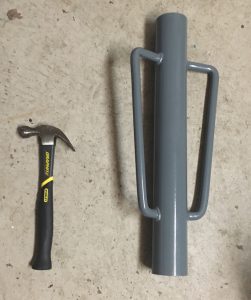The New Gardener: Protecting the garden from deer and other critters
Posted on: May 8, 2018 | Written By: Mike Palm |
Note: With the guidance of editor Doug Oster, new gardener Mike Palm will be chronicling his adventures (or perhaps misadventures) in starting a garden this year.
Before I planted anything, I knew I needed to get a fence up. Deer live everywhere in my area (a nearby neighborhood is called Deer Crossing.) And I really don’t feel the need to feed them any more than the rest of the plants in my yard are already doing.
Did you know deer can jump 15 feet high? I didn’t either, and I’m kind of glad I was unaware because I can’t imagine a 15-foot high fence. I’m going to hope that these suburban deer are lazy and will look elsewhere for easier pickings.
Doug says: That fence looks good. Even though the deer can jump that high, they don’t like to enter enclosed spaces. You’ll be very happy you took the time to construct the fence.
I also didn’t want to get too elaborate with a giant wood or metal fence because of the cost. So I settled on something makeshift that I could expand in the future. So I figured U-channel posts — 7 footers — would do the trick. Even after a few days of rain, it was no easy task getting them into the ground. I was able to get them around 4 or 5 inches in, but that didn’t seem very secure. Even putting on my heavy work boots and jumping on the flaps got me nowhere.
After an online search, it seemed like a post driver was the best bet. This video made it look easy, and I was able to find one at Tractor Supply Company. The post driver weighs 16 pounds, but it sunk those posts perfectly about a foot, leaving 6 feet exposed. (Side note 1: No blisters this time.) (Side note 2: If anybody’s looking to buy a slightly used post driver, let me know.)

All that, and that’s just the posts!
The local home improvement store had several material options for the barrier, ranging from galvanized steel wire to vinyl-coated deer fencing to wildlife netting. I sent a few pictures to Doug with options and he suggested a polypropylene mesh rolled fencing material that I had somehow overlooked.
Doug says: A good thick material will last for years. Even if you decide to replace the current fence, that deer netting will come in handy as you start to plant other things in your landscape.
In its rolled up form, it just looks black. But when it’s stretched out and hung up, it’s not that noticeable. The U-channel post has little hooks that I used to latch the netting on to, but I also added zip ties for more security.
The posts are 6 feet high and the netting is 7 feet high, so I left it a little long on the bottom so I could use metal landscape pins to further seal the barrier on the bottom. After pushing in about a dozen of these with my thumb, I smarted up and used a hammer the rest of the way.
My biggest issue now is an entrance. At the end of the fence, I’m using more zip ties that I’ll just cut each time I need to get in. Obviously that doesn’t seem like a long-term solution. So I’m throwing it out to you to give me some advice on what to do here:

You can email me at mpalm@535mediallc.com or comment on the Facebook posts.
Earlier New Gardener stories
Part 1: Picking A Garden Location
Part 2: Choosing A Size And Type Of Garden
Part 3: Completing The Setup Of The Raised Bed Gardens
More from Everybody Gardens
See also, Raised Bed Gardening Secrets Revealed By CobraHead Inventor.
Follow us on Twitter.